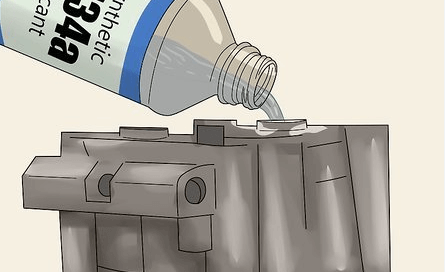To add oil to an A/C system, use an oil injector on the low-side port while the car is running and fully charged. This helps distribute the oil throughout the system.
It is important to add oil when recharging the system or if any refrigerant is lost, as the oil is also lost with it. Lack of compressor oil may result in issues such as humming sounds, refrigerant leaks, burning smells, and visible smoke.
Adding oil ensures proper lubrication and stability of the A/C system.
Understanding The Importance Of Adding Oil To A/c System
Properly lubricating the A/C system is crucial for maintaining its performance and longevity. By adding oil to the system, you ensure that all the components are well-lubricated, reducing friction and preventing costly damages.
Significance Of Proper Lubrication In The A/c System
A well-lubricated A/C system is essential for its smooth operation. The compressor, which is the heart of the system, relies on oil to stay lubricated. Without the correct amount and type of oil, the compressor can experience increased wear and tear, leading to inefficient cooling and potential breakdowns.
Moreover, proper lubrication reduces the risk of compressor overheating. As the compressor works, it generates heat, and the oil helps dissipate this heat. Without sufficient lubrication, the compressor can overheat, affecting the overall performance of the A/C system.
Role Of Oil In Maintaining System Performance And Longevity
The oil in the A/C system plays a vital role in preserving its performance and lifespan. It acts as a lubricant, ensuring smooth movement and reducing friction between the system’s components. This lubrication prevents excessive wear and tear, ultimately extending the lifespan of the A/C system.
Additionally, the oil helps seal the internal components, preventing refrigerant leaks and maintaining the system’s efficiency. It creates a barrier that prevents any potential leaks or damages, ensuring that the refrigerant stays contained within the system.
In summary, adding oil to your A/C system is a crucial maintenance step. It ensures proper lubrication, reduces friction, and prevents overheating, ultimately contributing to the system’s performance and longevity.

Credit: www.nytimes.com
Steps To Add Oil To A/c System
When it comes to maintaining your car’s air conditioning system, adding oil is an essential step to ensure its smooth operation. In this guide, we will walk you through the simple steps you need to follow to add oil to your A/C system. From preparing your tools to verifying the oil level, each step is crucial in keeping your A/C system in top condition.
Step 1: Prepare The Necessary Tools And Equipment
Before you start adding oil to your A/C system, it is important to gather all the necessary tools and equipment. Here is a list of what you will need:
- Refrigerant oil (specific to your A/C system)
- Oil injector or oil can with a flexible hose
- A/C manifold gauge set (for checking system pressure)
- Gloves and safety goggles
Step 2: Locate The Oil Port In The A/c System
The next step is to locate the oil port in your A/C system. The oil port is typically located on the compressor or near the low-pressure side of the system. Consult your car’s manual or look for online resources to identify the exact location of the oil port.
Step 3: Determine The Type And Amount Of Oil Required
Before adding oil to your A/C system, it is crucial to determine the type and amount of oil required. Different A/C systems require different types of refrigerant oil, such as PAG oil or ester oil. Refer to your car’s manual or consult a professional to ensure you use the correct oil for your specific A/C system. Additionally, the amount of oil to be added depends on the system’s capacity, which can also be found in your car’s manual.
Step 4: Safely Add Oil To The A/c System
Now it’s time to add oil to your A/C system. Follow these steps:
- Put on your safety goggles and gloves for protection.
- Connect the oil injector or oil can with the flexible hose to the oil port.
- In a slow and controlled manner, inject the appropriate amount of oil into the system. Ensure that you do not overfill.
- Once the oil is added, remove the oil injector or can and securely close the oil port.
Step 5: Verify The Oil Level And Functionality Of The System
After adding oil to your A/C system, it is crucial to verify the oil level and ensure the system is functioning properly. Use an A/C manifold gauge set to check the system’s pressure and make sure it is within the recommended range. Additionally, observe the system for any signs of leaks, such as refrigerant leaks or strange noises, which may indicate a problem.
By following these simple steps, you can easily add oil to your A/C system and keep it running smoothly. Regularly maintaining your A/C system will not only improve its performance but also extend its lifespan, ensuring you stay cool on those hot summer days.
Choosing The Right Type Of Oil For Your A/c System
When it comes to adding oil to your A/C system, it is crucial to choose the right type of oil that is compatible with your system. The oil plays a crucial role in lubricating the various components of the system and ensuring their smooth operation. In this section, we will discuss the different types of A/C system oils, the factors to consider when selecting the appropriate oil, and the importance of compatibility with the refrigerant and system components.
Understanding The Different Types Of A/c System Oils
There are various types of oils available for A/C systems, but the most commonly used are mineral oil, synthetic oil, and polyalkylene glycol (PAG) oil. Each type of oil has its own advantages and disadvantages, and it is essential to understand their characteristics before making a choice.
In terms of lubricating properties, mineral oil is a traditional option that provides adequate lubrication but may not be suitable for newer A/C systems. Synthetic oil, on the other hand, offers better lubrication and stability, making it ideal for high-performance systems. PAG oil is specifically designed for use with newer systems that use R134a refrigerant and is highly compatible with both the refrigerant and system components.
Factors To Consider When Selecting The Appropriate Oil
When selecting the appropriate oil for your A/C system, several factors need to be considered:
- Type of refrigerant: It is essential to choose an oil that is compatible with the refrigerant used in your A/C system. For example, if your system uses R134a refrigerant, PAG oil is the recommended choice.
- System components: Different A/C systems may have varying components such as seals, gaskets, and hoses. It is crucial to select an oil that is compatible with these components to prevent any potential damage or leaks.
- Viscosity: The viscosity of the oil affects its flow and lubrication properties. It is vital to choose an oil with the correct viscosity for your system to ensure optimal performance.
- System specifications: Always refer to the manufacturer’s recommendations or consult a professional to determine the specific oil requirements for your A/C system.
Compatibility With The Refrigerant And System Components
Compatibility is a crucial aspect when selecting the oil for your A/C system. Both the refrigerant and system components should be compatible with the chosen oil to ensure proper lubrication and smooth functioning of the system. Using an incompatible oil can lead to insufficient lubrication, which can result in component damage, leaks, and reduced performance.
To ensure compatibility, check the oil specifications provided by the manufacturer and follow their recommendations. Additionally, it is advisable to consult with a professional or refer to the vehicle’s manual for specific guidelines regarding oil selection.
By considering the different types of A/C system oils, factors to consider when selecting the appropriate oil, and ensuring compatibility with the refrigerant and system components, you can add the right oil to your A/C system and maintain its optimal performance.
Common Questions And Concerns About Adding Oil To A/c System

When it comes to maintaining and servicing your A/C system, one important aspect is ensuring that there is enough oil in the system. However, many people have common questions and concerns when it comes to adding oil to their A/C system. In this section, we will address some of the most frequently asked questions to help you understand the process better.
Do I Need To Add Oil If I Evacuate The Old Refrigerant And Replace It With A New One?
Yes, it is essential to add oil to the A/C system even if you have evacuated the old refrigerant and replaced it with a new one. The oil not only lubricates the compressor but also helps ensure proper cooling and prevent damage to the system. When you evacuate the system, you may unintentionally remove some of the oil along with the refrigerant. Therefore, it is crucial to replenish the oil to maintain the optimum performance of your A/C system.
How Much Oil Should Be Added After Recharging The Refrigerant?
The amount of oil to be added after recharging the refrigerant depends on the specific make and model of your A/C system. It is essential to consult the manufacturer’s guidelines or refer to your vehicle’s service manual for the precise oil capacity. Typically, the oil capacity ranges from 2 to 8 ounces, but this can vary. To ensure accuracy, use a graduated oil injector or consult a professional technician who can help you determine the correct amount of oil to add. Adding too little or too much oil can affect the performance and longevity of your A/C system.
Precautions And Considerations When Adding Oil To A New A/c Compressor
Adding oil to a new A/C compressor requires some precautions and considerations to ensure the longevity and efficiency of the system. Here are a few essential points to keep in mind:
- Use the specific type and viscosity of oil recommended by the compressor manufacturer. Different compressors may require different oils, so it is crucial to use the correct type to avoid any potential damage.
- Ensure that the oil is clean and free from any contaminants. Contaminated oil can clog the system and cause malfunctions.
- Properly measure the amount of oil required for the new compressor. Refer to the manufacturer’s guidelines or consult a professional technician for the accurate oil capacity.
- Avoid overfilling the compressor with oil. Excessive oil can result in poor performance and potential damage to the system.
- Always refer to the specific instructions provided by the compressor manufacturer for the proper oiling procedure and any additional precautions or considerations.
By following these precautions and considerations when adding oil to a new A/C compressor, you can ensure the optimal performance and longevity of your A/C system.
Maintenance Tips To Ensure Proper Oil Levels In The A/c System
Proper maintenance of the oil levels in your car’s A/C system is crucial for its optimal performance and longevity. Regular inspection and monitoring of the oil levels, along with understanding the potential issues caused by insufficient or excessive oil, are essential steps to keep your A/C system running smoothly. In this article, we will discuss the recommended maintenance intervals for checking and adding oil to ensure the proper functioning of your A/C system.
Regular Inspection And Monitoring Of Oil Levels
Inspecting and monitoring the oil levels in your A/C system should be part of your regular maintenance routine. This ensures that the system is adequately lubricated and helps identify any potential issues before they escalate into major problems. Here are some key points to keep in mind:
- Check the oil levels at least once every six months or as recommended by your vehicle manufacturer.
- Inspect the oil sight glass or dipstick to determine the oil level. Make sure to consult your vehicle’s manual for the exact location and instructions.
- If the oil level appears low, it may indicate a leak in the system. In such cases, it’s important to have the A/C system inspected by a professional technician.
Potential Issues Caused By Insufficient Or Excessive Oil
Both insufficient and excessive oil levels can lead to various problems in your A/C system. It’s important to understand these issues to address them promptly. Here are a few potential consequences:
- Insufficient oil:
- Poor lubrication can lead to increased friction, causing wear and tear on the compressor and other components.
- Reduced cooling capacity and inefficient performance due to insufficient lubrication of the moving parts.
- Possible damage to the compressor, which is a vital component of the A/C system.
- Excessive oil:
- Overfilling the system with oil can lead to a decrease in cooling efficiency.
- Oil foaming can occur, which can restrict the flow of refrigerant and reduce the system’s functionality.
- Possible damage to the compressor due to excessive oil foaming.
Recommended Maintenance Intervals For Checking And Adding Oil
To ensure the proper oil levels in your A/C system, it’s crucial to follow the recommended maintenance intervals. These intervals may vary depending on your vehicle manufacturer and usage, so it’s important to consult your vehicle’s manual for specific guidelines. However, as a general rule of thumb:
- Check the oil levels every six months or as recommended by your vehicle manufacturer.
- If the oil level is low, consult a professional technician to identify and rectify any potential leaks or issues.
- Add oil as per the manufacturer’s recommendations using the appropriate oil viscosity and type.
Regular inspection and maintenance of your A/C system’s oil levels ensure that the system functions optimally, providing efficient cooling performance when you need it the most. By following these maintenance tips, you can avoid costly repairs and keep your A/C system in top-notch condition for years to come.
Frequently Asked Questions On How To Add Oil To A/c System
How Do You Know If Your Ac Compressor Needs Oil?
If your AC compressor lacks oil, you may notice humming sounds, refrigerant leaks, burning smells, or visible smoke. It’s recommended to add oil when refrigerant is lost, as the oil is also lost under pressure and can cause issues.
Do I Need To Add Oil To Ac System?
Yes, you need to add oil to the AC system. When refrigerant is lost, oil is also lost as it becomes a fine mist under pressure. Adding oil is important to maintain proper lubrication and prevent damage to the system.
Do I Need To Add Oil After Evacuating Car Ac?
Yes, it is recommended to add oil to the AC system after evacuating it. When refrigerant is lost, the oil is also lost as it becomes a fine mist under pressure. Adding oil ensures proper lubrication.
How Do I Add Oil To The A/c System?
To add oil to the A/C system, first, locate the oil fill valve on the compressor. Remove the cap and pour the recommended amount of oil into the system using a funnel. Replace the cap securely after adding the oil.
It is important to refer to your vehicle’s manual for the correct type and amount of oil to use.
Conclusion
Adding oil to an A/C system is essential for maintaining its performance and preventing damage. Insufficient lubrication can lead to friction, wear, and failure of components. Whether you are recharging the system or replacing a compressor, adding oil is necessary to ensure proper lubrication.
Remember to use the correct type and viscosity of oil for your specific A/C system. Be cautious not to overcharge the system, as this can cause problems as well. By understanding the importance of adding oil and following the correct procedures, you can keep your A/C system running smoothly and efficiently.


Leave a Reply